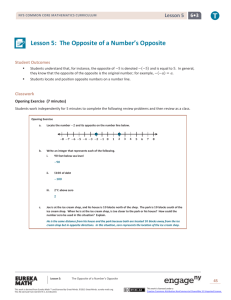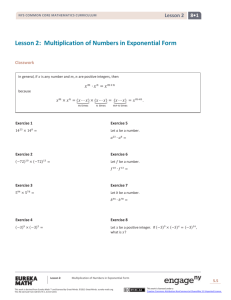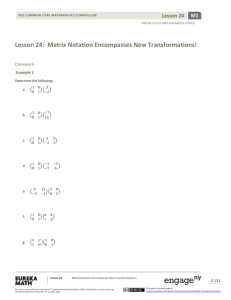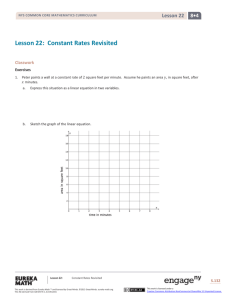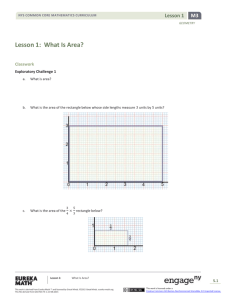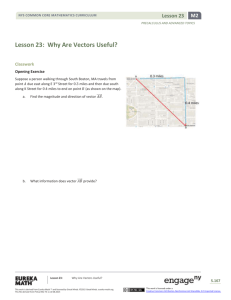Lesson 25: First-Person Computer Games
advertisement
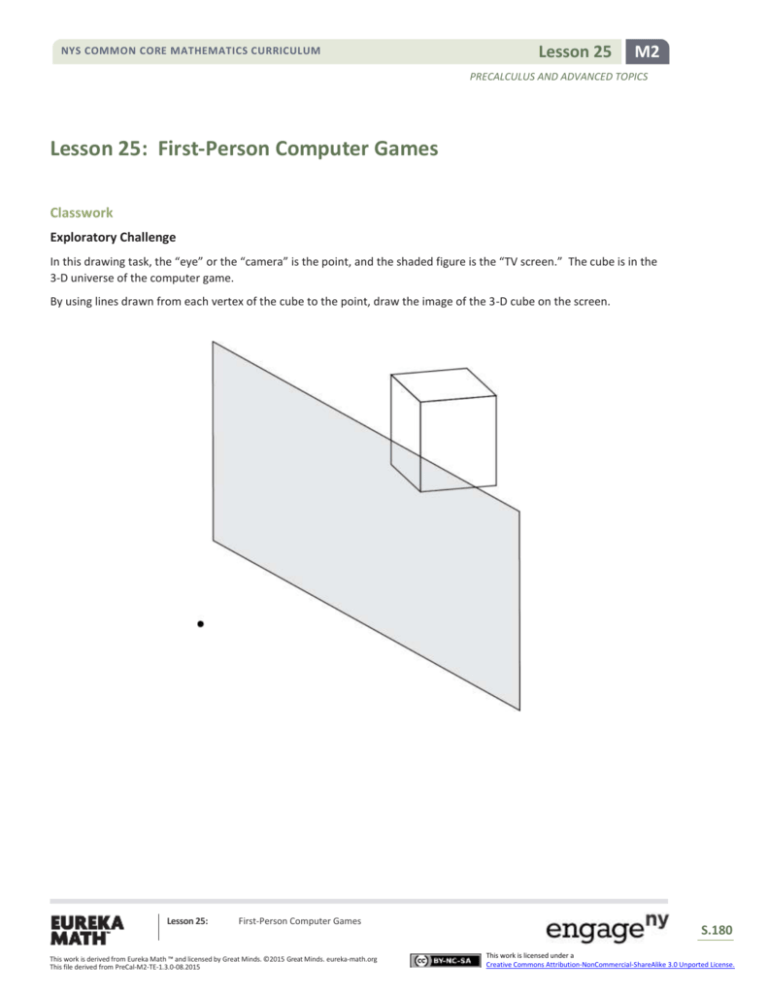
NYS COMMON CORE MATHEMATICS CURRICULUM Lesson 25 M2 PRECALCULUS AND ADVANCED TOPICS Lesson 25: First-Person Computer Games Classwork Exploratory Challenge In this drawing task, the “eye” or the “camera” is the point, and the shaded figure is the “TV screen.” The cube is in the 3-D universe of the computer game. By using lines drawn from each vertex of the cube to the point, draw the image of the 3-D cube on the screen. Lesson 25: First-Person Computer Games This work is derived from Eureka Math ™ and licensed by Great Minds. ©2015 Great Minds. eureka-math.org This file derived from PreCal-M2-TE-1.3.0-08.2015 S.180 This work is licensed under a Creative Commons Attribution-NonCommercial-ShareAlike 3.0 Unported License. NYS COMMON CORE MATHEMATICS CURRICULUM Lesson 25 M2 PRECALCULUS AND ADVANCED TOPICS Example 1. When three-dimensional objects are projected onto screens with finite dimensions, it often limits the field of view (FOV), or the angle the scene represents. This limiting effect can vary based on the size of the screen and position of the observer. a. Sketch a diagram that could be used to calculate a viewer’s field of view 𝜃 in relation to the horizontal width of the screen 𝑤 and the distance the viewer is from the screen 𝑑. b. Assume that a person is sitting directly in front of a television screen whose width is 48 inches at a distance of 8 feet from the screen. Use your diagram and right-triangle trigonometry to find the viewer’s horizontal field of view 𝜃. c. How far would a viewer need to be from the middle of a computer screen with a width of 15 inches to produce the same field of view as the person in front of the television? Lesson 25: First-Person Computer Games This work is derived from Eureka Math ™ and licensed by Great Minds. ©2015 Great Minds. eureka-math.org This file derived from PreCal-M2-TE-1.3.0-08.2015 S.181 This work is licensed under a Creative Commons Attribution-NonCommercial-ShareAlike 3.0 Unported License. Lesson 25 NYS COMMON CORE MATHEMATICS CURRICULUM M2 PRECALCULUS AND ADVANCED TOPICS d. Write a general statement about the relationship between screen size and field of view. Exercise 1 In this drawing task, the “eye” or the “camera” is the point, and the shaded figure is the “TV screen.” The cube is in the 3-D universe of the computer game. By using lines drawn from each vertex of the cube to the point, draw the image of the 3-D cube on the screen. A horizon line and two additional vanishing points have been included to help you. The image point of the first vertex is shown. 𝑉2 𝑃1 𝑃1 ′ 𝑉3 𝑉1 Lesson 25: First-Person Computer Games This work is derived from Eureka Math ™ and licensed by Great Minds. ©2015 Great Minds. eureka-math.org This file derived from PreCal-M2-TE-1.3.0-08.2015 S.182 This work is licensed under a Creative Commons Attribution-NonCommercial-ShareAlike 3.0 Unported License. NYS COMMON CORE MATHEMATICS CURRICULUM Lesson 25 M2 PRECALCULUS AND ADVANCED TOPICS Exercise 2 Let’s assume that the point 𝑉1 in our projection diagram is at the origin and the upper-right vertex of the cube is located 5 at (8). If our screen represents the plane 𝑦 = 2, use matrix multiplication to determine the vector that represents the 4 line of sight from the observer to the projected point on the screen. Explain your thinking. Lesson 25: First-Person Computer Games This work is derived from Eureka Math ™ and licensed by Great Minds. ©2015 Great Minds. eureka-math.org This file derived from PreCal-M2-TE-1.3.0-08.2015 S.183 This work is licensed under a Creative Commons Attribution-NonCommercial-ShareAlike 3.0 Unported License. Lesson 25 NYS COMMON CORE MATHEMATICS CURRICULUM M2 PRECALCULUS AND ADVANCED TOPICS Problem Set 1. Projecting the image of a three-dimensional scene onto a computer screen has the added constraint of the screen size limiting our field of view, or FOV. When we speak of FOV, we wish to know what angle of view the scene represents. Humans have remarkably good peripheral vision. In New York State, the requirement for a driver’s license is a horizontal FOV of no less than 140°. There is no restriction placed on the vertical field of vision, but humans normally have a vertical FOV greater than 120°. a. Consider the (simulated) distance the camera is from the screen as 𝑑, the horizontal distance of the screen as 𝑤, and the horizontal FOV as 𝜃. Then use the diagram below and right-triangle trigonometry to help you find 𝜃 in terms of 𝑤 and 𝑑. 𝑤 𝑑 𝜃 2 b. Repeat procedures from part (a), but this time let ℎ represent the height of the screen and 𝜓 represent the vertical FOV. ℎ 𝑑 𝜓 2 c. If a particular game uses an aspect ratio of 16: 9 as its standard view and treats the camera as though it were 8 units away, find the horizontal and vertical FOVs for this game. Round your answers to the nearest degree. d. When humans sit too close to monitors with FOVs less than what they are used to in real life or in other games, they may grow dizzy and feel sick. Does the game in part (c) run the risk of that? Would you recommend this game be played on a computer or on a television with these FOVs? Lesson 25: First-Person Computer Games This work is derived from Eureka Math ™ and licensed by Great Minds. ©2015 Great Minds. eureka-math.org This file derived from PreCal-M2-TE-1.3.0-08.2015 S.184 This work is licensed under a Creative Commons Attribution-NonCommercial-ShareAlike 3.0 Unported License. Lesson 25 NYS COMMON CORE MATHEMATICS CURRICULUM M2 PRECALCULUS AND ADVANCED TOPICS 2. 3. Computers regularly use polygon meshes to model three-dimensional objects. Most polygon meshes are a collection of triangles that approximate the shape of a three-dimensional object. If we define a face of a polygon mesh to be a triangle connecting three vertices of the shape, how many faces at minimum do the following shapes require? a. A cube f. An octahedron b. A pyramid with a square base g. A dodecahedron c. A tetrahedron h. An icosahedron d. A rectangular prism i. How many faces should a sphere have? e. A triangular prism In the beginning of 3-D graphics, objects were created only using the wireframes from a polygon mesh without shading or textures. As processing capabilities increased, 3-D models became more advanced, and shading and textures were incorporated into 3-D models. One technique that helps viewers visualize how shading works on a 3-D figure is to include both an “eye” and a “light source.” Vectors are drawn from the eye to the figure, and then reflected to the light (this technique is called ray tracing). See the diagram below. “light source” “eye” or “camera” a. Using this technique, the hue of the object depends on the sum of the magnitudes of the vectors. Assume the 4 “eye” in the picture above is located at the origin, 𝐯𝐬 is the vector from the eye to the location (5), and the 3 5 “light source” is located at (6). Then find 𝐯𝐥 , the vector from 𝐯𝐬 to the light source, and the sum of the 8 magnitudes of the vectors. b. What direction does light travel in real life, and how does this compare to the computer model portrayed above? Can you think of any reason why the computer only traces the path of vectors that start at the “eye?” Lesson 25: First-Person Computer Games This work is derived from Eureka Math ™ and licensed by Great Minds. ©2015 Great Minds. eureka-math.org This file derived from PreCal-M2-TE-1.3.0-08.2015 S.185 This work is licensed under a Creative Commons Attribution-NonCommercial-ShareAlike 3.0 Unported License.





